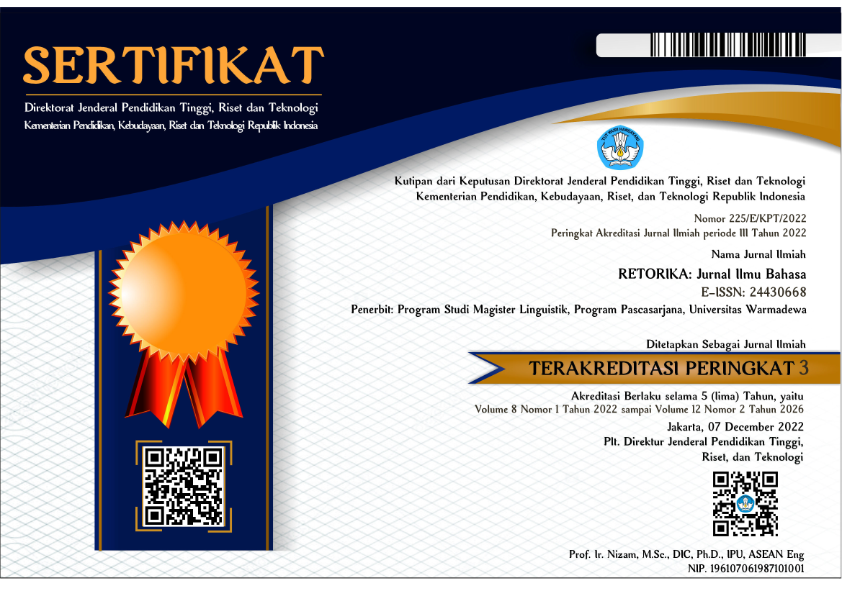Textual Discourse Analysis in the Raya and the Last Dragon Movie
Abstract
is study examines textual discourse in the animated movie “Raya and the Last Dragon,” with a focus on grammatical and lexical cohesion to understand how language supports narrative coherence and emotional impact. Although there is substantial research on textual cohesion and discourse patterns in various contexts, there is a notable gap in investigating how animated films, which merge visual and verbal elements, use these linguistic techniques to construct complex narratives. This research addresses this gap by applying Halliday and Hasan's (1976) theoretical framework to analyze how cohesive devices function within the film’s dialogues. Through the descriptive-qualitative method, the research explores cohesive devices to enhance our comprehension of this linguistic phenomenon. Data collection involved meticulously observing the movie and analyzing the data through both formal and informal methods. The analysis revealed 416 instances of grammatical elements, with references being the most frequently used. These references ensure clarity and continuity in dialogues by linking back to previously mentioned characters or objects, thereby keeping the conversation smooth and coherent. In the lexical analysis, 78 instances were identified, with repetition being the most common. Repetition emphasized key themes, strengthened emotional connections, and effectively conveyed the movie's main messages. This study provides new insights into how animated films uniquely employ cohesive devices to enhance storytelling and character development, and contributing to the broader field of textual discourse analysis.
References
Astiari, Budiarta, & Pratama. (2019). The Translation of Reiteration. RETORIKA: Jurnal Ilmu Bahasa, 5, No 2, 138-147.
Ayomi, P. N. (2016). Introduction to Discourse Analysis. STIBA Saraswati Denpasar.
Halliday, M., & Hasan, R. (1976). Cohesion in English. London: Longman.
Halliday, M., & Hasan, R. (1989). Language, context, and text: aspects of language in a social-semiotic perspective. Oxford University Press.
Hornby, A. (2006). Oxford Advanced Learner's Dictionary: Resource book. Oxford University Press.
Kamalu, I., & Osisanwo, A. (2015). Discourse Analysis. Krafts Books Limited.
Kothari, C. (2004). Reseach methodology: Methods and techniques (2nd revised edition). New Delhi: New Age International (P) Limited, Publishers.
Paltridge, B. (2007). Discourse Analysis. London: Bloomsbury Academic.
Putri, Simpen, Suparwa, & Malini. (2024). Gender Representation in Indonesian Language Textbooks: Critical Discourse Analysis. Theory and Practice in Language Studies, 14, No 1, 248-256.
Que, S. R., & Patty, J. (2023). Analyzing the Lyrics of 'How Do I Live': A study on Textual and Contextual Perspectives. MATAI: International Journal of Language Education, 45-59.
Renkema, J., & Schubert, C. (2018). Introduction to Discourse Studies. Routledge.
Sumarlam, M. (2013). Teori dan Praktik Analisis Wacana. bukuKatta.
Tiantian, H. (2023). Textual Cohesion in Journal Article Abstracts by Chinese and Native English Scholars in Applied Linguistics: A Comparative Study. Academic Journal of Humanities & Social Sciences, 6(16), 87-95.
Yule, G. (1996). Pragmatics. Oxford University Press.
Yule, G. (2017). The Study of Language. Cambridge University Press.
Copyright (c) 2024 RETORIKA: Jurnal Ilmu Bahasa

This work is licensed under a Creative Commons Attribution-ShareAlike 4.0 International License.
This journal provides immediate open access to its content on the principle that making research freely available to the public supports a greater global exchange of knowledge.
All articles published Open Access will be immediately and permanently free for everyone to read and download. We are continuously working with our author communities to select the best choice of license options, currently being defined for this journal as follows: Creative Commons-Non Ceomercial-Attribution-ShareAlike (CC BY-NC-SA)
 Abstract viewed = 17 times
Abstract viewed = 17 times
 PDF downloaded = 22 times
PDF downloaded = 22 times

2.png)














